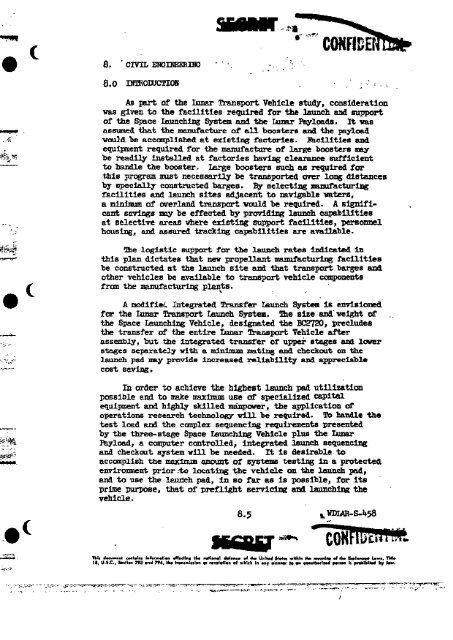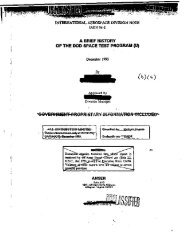LUNAR EXPEDITION PLAN
LUNAR EXPEDITION PLAN
LUNAR EXPEDITION PLAN
Create successful ePaper yourself
Turn your PDF publications into a flip-book with our unique Google optimized e-Paper software.
8. ' CIVIL ENGHJEERIBG<br />
8.0 nnBOKJcnoN :<br />
As part of the Lunar Transport Vehicle study, consideration<br />
vas given to the facilities required for the launch and support<br />
of the Space Launching System and the Lunar Bayloads. It vas<br />
assumed that the manufacture of all boosters and the payload<br />
vould be accomplished at existing factories, facilities and<br />
equipment required for the manufacture of large boosters may<br />
be readily Installed at factories having clearance sufficient<br />
to handle the booster. Large boosters such as required for<br />
this prograis must necessarily be transported over long distances<br />
by specially constructed barges, By selecting manufacturing<br />
facilities and launch sites adjacent to navigable waters,<br />
a minimum of overland transport vould be required. A significant<br />
savings may be effected by providing launch capabilities<br />
at selective areas where existing support facilities, personnel<br />
housing, and assured tracking capabilities are available.<br />
The logistic support for the launch rates indicated in<br />
this plan dictates that new propel! ant manufacturing facilities<br />
be constructed at the launch site and that transport barges and<br />
other vehicles be available to 'transport vehicle components<br />
from the manufacturing plants.<br />
A modified Integrated Transfer Launch System is envisioned<br />
for the Lunar Transport Launch System. The size and weight of<br />
the Space Launching Vehicle, designated the BC2720, precludes<br />
the transfer of the entire Lunar Transport Vehicle after<br />
assembly, but the Integrated transfer of upper stages and lower<br />
stages separately with a minimum mating and checkout on the<br />
launch pad may provide increased reliability and appreciable<br />
cost savingt<br />
In order to achieve the highest launch pad utilization<br />
possible and to make maximum use of specialized capital<br />
equipment and highly skilled manpower, the application of<br />
operations research technology will be required. To handle the<br />
test load and the complex sequencing requirements presented<br />
by the three-stage Space launching Vehicle plus the Lunar<br />
Payload, a computer controlled, integrated launch sequencing<br />
and checkout system will be needed. It 1B desirable to<br />
accomplish the maximum amount of systems testing In a protected<br />
environment prior .-to locating the vehicle on the launch pad,<br />
and to use the launch pad, in so far as Is possible, for its<br />
prime purpose, that of preflight servicing and launching the<br />
vehicle.<br />
8.5 ^WDLAR-S-fcsa<br />
KGfitf-<br />
Thti rfaciimni contoiu information affadini tbt nttanal satania af Iha Unltarf atofcn wtthtn tha awanint at Ik. bplanaa* lawm, TMa<br />
IS, M.I.C., Mellon 793 and 794, la* troniniiilon or mvalatien a! wfcich In an* poriMlr to *• anamfcartino' pwrta* h praaiblrad ay lav.<br />
I




